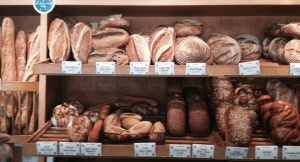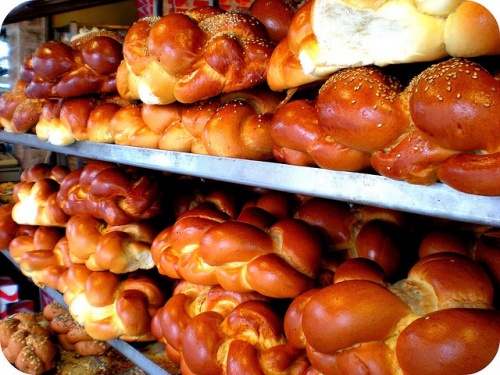The aroma of baking bread is so universally appealing that an appreciation for it is probably hardwired into our DNA. One good sniff of that warm bread smell and we are transported to childhood…a cozy kitchen, or perhaps a trip to the local bakery, where golden brown loaves were laid out shoulder to shoulder on wire racks behind the counter.
What we think about when we think about bread
Bread: putting the ingredients into a bowl, adding the liquid to the flour, adding the yeast; and kneading, getting fingers into the sticky dough and working it, working it, until it becomes smooth and elastic. The dough goes into a bowl and you cover it with a cloth to let it rise, and then you can go and do things or read a book or sit and think while the dough rises and fills the bowl with its growing roundness. Then you punch that dough, punch it down, knock all the air out of it, but with all good intentions. It will rise again; if you have done everything right and there isn’t a draft and you give it enough time, it will rise. The risen dough will fall out of the bowl when you turn it over, and you can put it in a bread pan or you can form it into a loaf that stands free — you decide.
Stop a minute to admire the unbaked loaf. You have molded it with your hands, created it out of things that by themselves are not bread, have no resemblance to bread, just liquids and powders, as fine as can be, that will transform in the heat of the oven, change into something that will have heft and density that you can cut into thick slices and slather with butter or jam and it will be gone too soon because most people cannot resist fresh bread. You spend so much time on it, and then it disappears into sandwiches or toast and finally crumbs— just like that.
What do you think of when you think of bread? Square or roundish slices of white, wheat, whole grain, multi-grain, raisin, rye —dark or light— or pumpernickel; sticky loaves swirled with cinnamon and sugar; potato bread, olive bread, pockets of pita, golden braided challah with sesame seeds or poppy seeds on top. Heavy and dense or full of air, sprinkled with nuts or herbs or salt; long and skinny or round and flat. Crusty sourdough, scored into squares on top, crunchy on the outside and tooth-resistant on the inside, loaves that cry out for crab to go with them. Free-form rustic loaves baked golden brown in brick ovens, their crusts as rough as a stuccoed wall. Tear off hunks of sturdy round loaves and use them to soak up soup or sauce, chili or gravy. Add anything between two slices, make it the way you want. It’s bread, ready to become whatever you like.
And finally, you can feed the crusts to the birds. My grandfather kept a big box of stale bread for such occasions. Here we are, keeping the pigeons well fed.
It’s Shabbat, so one last image. . .
. . .and a blessing:





I read your musings and childhood memories pass before me. The local bakery made crimp bread on Thursday (?) and I would accompany my big sister to purchase a loaf of warm bread….home to spread some butter and enjoy the aroma and taste. It was better than dessert!
Yes, Sheila– I agree. Warm bread with butter is the best! Thanks for writing (and reading!).
What a mouth-watering post, Risa! Now I know who to turn to should I ever get up the nerve to make a loaf myself someday. Nice job.
Thanks, Cindy. You can do it! I would say “rise to the occasion,” but that would be pretty corny.
Memories of walking home from school and smelling the fresh bread from the open front door. Knowing I’d soon be biting into a still warm Brioche. Now that I think of it, my Mom timed it just right, knowing the smells would entice us, and make us happy. She would form one ball and press a smaller one on top, such fun to pull off the top and pop it into my mouth. Of course, there was the butter! I enjoy your stories Risa.
Great memories, Vivian! Thanks for your comment.